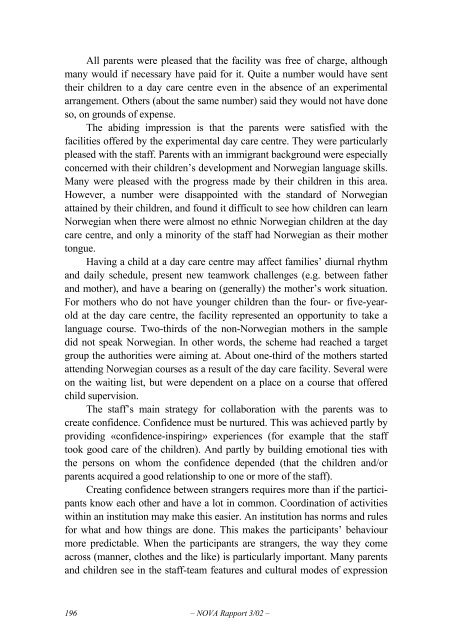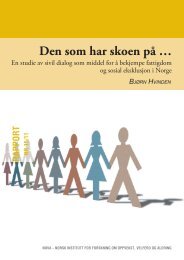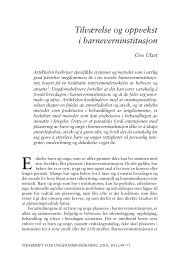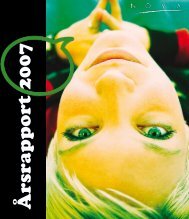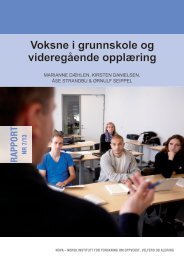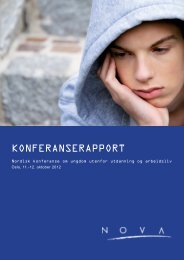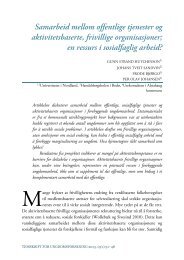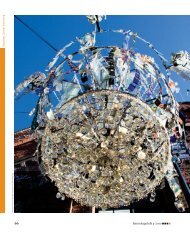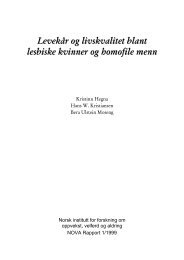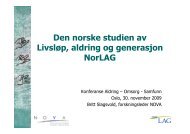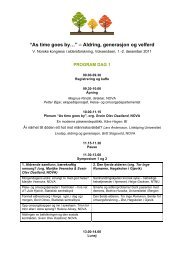NOVA Rapport 3/2002
NOVA Rapport 3/2002
NOVA Rapport 3/2002
Create successful ePaper yourself
Turn your PDF publications into a flip-book with our unique Google optimized e-Paper software.
All parents were pleased that the facility was free of charge, although<br />
many would if necessary have paid for it. Quite a number would have sent<br />
their children to a day care centre even in the absence of an experimental<br />
arrangement. Others (about the same number) said they would not have done<br />
so, on grounds of expense.<br />
The abiding impression is that the parents were satisfied with the<br />
facilities offered by the experimental day care centre. They were particularly<br />
pleased with the staff. Parents with an immigrant background were especially<br />
concerned with their children’s development and Norwegian language skills.<br />
Many were pleased with the progress made by their children in this area.<br />
However, a number were disappointed with the standard of Norwegian<br />
attained by their children, and found it difficult to see how children can learn<br />
Norwegian when there were almost no ethnic Norwegian children at the day<br />
care centre, and only a minority of the staff had Norwegian as their mother<br />
tongue.<br />
Having a child at a day care centre may affect families’ diurnal rhythm<br />
and daily schedule, present new teamwork challenges (e.g. between father<br />
and mother), and have a bearing on (generally) the mother’s work situation.<br />
For mothers who do not have younger children than the four- or five-yearold<br />
at the day care centre, the facility represented an opportunity to take a<br />
language course. Two-thirds of the non-Norwegian mothers in the sample<br />
did not speak Norwegian. In other words, the scheme had reached a target<br />
group the authorities were aiming at. About one-third of the mothers started<br />
attending Norwegian courses as a result of the day care facility. Several were<br />
on the waiting list, but were dependent on a place on a course that offered<br />
child supervision.<br />
The staff’s main strategy for collaboration with the parents was to<br />
create confidence. Confidence must be nurtured. This was achieved partly by<br />
providing «confidence-inspiring» experiences (for example that the staff<br />
took good care of the children). And partly by building emotional ties with<br />
the persons on whom the confidence depended (that the children and/or<br />
parents acquired a good relationship to one or more of the staff).<br />
Creating confidence between strangers requires more than if the participants<br />
know each other and have a lot in common. Coordination of activities<br />
within an institution may make this easier. An institution has norms and rules<br />
for what and how things are done. This makes the participants’ behaviour<br />
more predictable. When the participants are strangers, the way they come<br />
across (manner, clothes and the like) is particularly important. Many parents<br />
and children see in the staff-team features and cultural modes of expression<br />
196<br />
– <strong>NOVA</strong> <strong>Rapport</strong> 3/02 –


